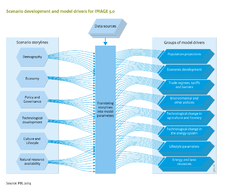Drivers/Policy issues: Difference between revisions
< Drivers
Jump to navigation
Jump to search
Oostenrijr (talk | contribs) m (Text replace - "Policy interventions per component overview" to "Policy interventions and components overview") |
Oostenrijr (talk | contribs) No edit summary |
||
| Line 2: | Line 2: | ||
|PageLabel=Policy issues | |PageLabel=Policy issues | ||
|Sequence=4 | |Sequence=4 | ||
|Reference=Moss et al., 2010; Van Vuuren et al., 2012; Ebi et al., 2013; Lutz and KC, 2010; Dellink et al., forthcoming; KC and Lutz, forthcoming; IIASA, 2013; | |Reference=Moss et al., 2010; Van Vuuren et al., 2012; Ebi et al., 2013; Lutz and KC, 2010; Dellink et al., forthcoming; KC and Lutz, forthcoming; IIASA, 2013; | ||
|Description=<h2>Baseline developments </h2> | |Description=<h2>Baseline developments </h2> | ||
Under baseline conditions, scenario drivers are assumed to develop either along the pathway considered the ‘best guess’ translation of current trends into the future, or multiple contrasting scenarios are considered to explore the range of plausible future trends. The first approach has been chosen for many studies, such as the OECD Environmental Outlook to 2050 ([[OECD, 2012]]), as starting point for policy interventions to improve the baseline outcomes within and across sectors and issues. The second approach recognises structural uncertainties in how the world may develop, and explores how such uncertainties would play out in a future range of outcomes. Multiple contrasting scenarios also serve to investigate how robust policy interventions play out under different future conditions. Examples of multiple baseline studies are the Special Report on Emissions Scenarios ([[IPCC, 2000]]) and the Millennium Ecosystem Assessment ([[MA, 2005]]). | Under baseline conditions, scenario drivers are assumed to develop either along the pathway considered the ‘best guess’ translation of current trends into the future, or multiple contrasting scenarios are considered to explore the range of plausible future trends. The first approach has been chosen for many studies, such as the OECD Environmental Outlook to 2050 ([[OECD, 2012]]), as starting point for policy interventions to improve the baseline outcomes within and across sectors and issues. The second approach recognises structural uncertainties in how the world may develop, and explores how such uncertainties would play out in a future range of outcomes. Multiple contrasting scenarios also serve to investigate how robust policy interventions play out under different future conditions. Examples of multiple baseline studies are the Special Report on Emissions Scenarios ([[IPCC, 2000]]) and the Millennium Ecosystem Assessment ([[MA, 2005]]). | ||
| Line 9: | Line 9: | ||
===Population projections=== | ===Population projections=== | ||
The wide range of long-term populations projections is presented in | The wide range of long-term populations projections is presented in the figure below. By 2100, the world population could be either about the same as today or double. The projections were made by IIASA using a population modelling approach ([[Lutz and KC, 2010]]) that links aggregate education levels to fertility and mortality rates per country. Together with migration flows, these rates determine the size of the future population. ([[Dellink et al., forthcoming]]; [[KC and Lutz, forthcoming]]). | ||
Using population projections and the underlying educational attainment per age cohort, long-term economic growth models project economic development expressed as GDP per capita. For the SSPs, economic development up to 2100 has been calculated by three different teams at [[OECD]], [[IIASA]] and [[PIK]], using their own models. GDP projections from the OECD model [[ENV-Growth model|ENV-Growth]] ([[Dellink et al., forthcoming]]) differ by a factor of up to 3.7 (see | Using population projections and the underlying educational attainment per age cohort, long-term economic growth models project economic development expressed as GDP per capita. For the SSPs, economic development up to 2100 has been calculated by three different teams at [[OECD]], [[IIASA]] and [[PIK]], using their own models. GDP projections from the OECD model [[ENV-Growth model|ENV-Growth]] ([[Dellink et al., forthcoming]]) differ by a factor of up to 3.7 (see the figure at the bottom, left). The differences in population and economic growth rates between countries and regions mean that the distribution of total economic assets is likely to shift, with Asia in the lead, followed later by Africa and, to a lesser extent, by Latin America (see the figure at the bottom, middle). | ||
=== Models, scenario story lines and results=== | === Models, scenario story lines and results=== | ||
As different models have been used, we can investigate how different model structures and assumptions and different interpretations of the qualitative scenario storylines in model parameters lead to quite different results (see | As different models have been used, we can investigate how different model structures and assumptions and different interpretations of the qualitative scenario storylines in model parameters lead to quite different results (see the figure at the bottom, right). Projections for the SSP3 scenario made by different teams not only differ with respect to the levels projected for 2100, but also with respect to the profile over the century. | ||
For more information on baseline scenarios in economic, social and ecological terms, see the results obtained in the IMAGE 3.0 framework in the 'Policy issues' pages of the [[Framework overview|Components]]. | For more information on baseline scenarios in economic, social and ecological terms, see the results obtained in the IMAGE 3.0 framework in the 'Policy issues' pages of the [[Framework overview|Components]]. | ||
Revision as of 09:08, 24 June 2014
Parts of Drivers/Policy issues
| Projects/Applications |
| Models/Databases |
| Relevant overviews |
| Key publications |
| References |
